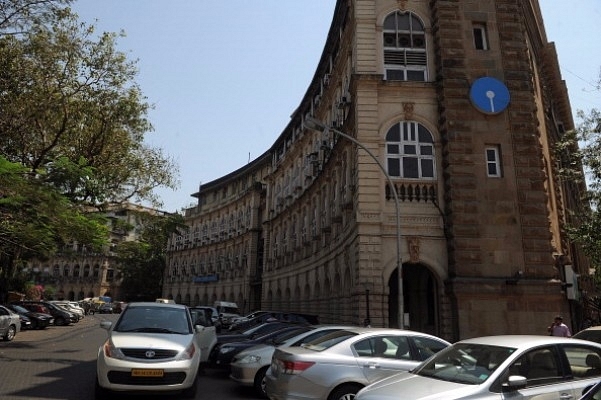Business
Why Bad News From SBI And BoB Is Not A Cause For Excess Gloom On PSU Banks
- There is good reason not to be too depressed by the big provisions – and lower profits or losses – reported by BoB and SBI.
- They may not be indicators of things getting worse, though the interest rate situation will bear watching. Any rise in rates will mean more treasury losses.

The State Bank of India’s Mumbai head office. (PUNIT PARANJPE/AFP/Getty Images)
The massive Rs 2,416 crore loss reported by the State Bank of India (SBI) in the quarter ended in December 2017 – its first quarterly loss in 17 years – sent shockwaves through the markets as one had presumed that bad news in the banking sector had started tapering off.
Coupled with Bank of Baroda’s (BoB) 56 per cent dip in net profits to Rs 112 crore, this suggests that 2018 has not begun on a good note for public sector banks despite the government’s announcement of a massive Rs 88,000 crore bank recapitalisation plan.
Let’s be clear: this is only the beginning of massive provisioning by public sector banks even as many bad loans are up for resolution at the bankruptcy courts (the National Company Law Tribunal), and as banks suffer treasury losses due to rising bond yields.
While SBI made a huge provision of Rs 17,760 crore, BoB made a provision of Rs 3,155 crore.
But while BoB’s net non-performing assets (NPAs) fell from 5.43 per cent to 4.97 per cent in the quarter, SBI’s went up from 5.43 per cent to 5.66 per cent.
So, is the banking sector going from bad to worse, or is the worst over? Are we going to see more red ink gush out of balance-sheets in the coming quarter?
Actually, it is a bit of both. The results will get worse, but the underlying situation may be getting better. There are two reasons for optimism, despite the recent bout of bad results.
First, the SBI’s big loss can partly be the result of new chairman Rajnish Kumar’s decision to accelerate provisioning at the start of his term. He took over from Arundhati Bhattacharya in October last year, and the high provisioning for that quarter relates substantially to Bhattacharya’s tenure. Moreover, SBI may also be paying the price for its shotgun merger of its subsidiaries with itself. The balance-sheets of its subsidiaries were often stretched more than that of the parent.
PSU banks tend to raise provisioning whenever a new chairman takes over because it allows him or her to get the bad news out first and ease the pressure in future quarters. In 2011, when O P Bhatt completed his five-year tenure at SBI, his successor Pratip Chaudhuri reported a near 99 per cent fall in the bank’s fourth quarter 2010-11 net profits.
In 2012-13, after Bank of Baroda chairman M D Mallya retired, his successor S Mundra reported a big dip in net profits in the third quarter. The same thing happened when Bank of India chairman T S Narayanaswami retired, and his successor made huge provisions in 2009-10, resulting in a fall of 42 per cent in net profits.
So, it is clear that new brooms tend to sweep cleaner, in part this is because it frontloads the bad news in the earlier part of a chairman’s tenure, for which they will not get any blame.
In SBI’s case, while the next quarter too could be difficult, according to Rajnish Kumar, one can expect a gradual revival from the first quarter of 2018-19.
The second reason for optimism is that the economy has started picking up from the last quarter of 2017-18, and there is a strong probability that corporate profitability will start improving from now onwards. Thus, even as banks will continue to make provisions as the bankruptcy process results in haircuts, these provisions may be more than balanced by improvements in the status of the overall loan portfolios as corporate cash flows improve.
If the government decision to pump in Rs 80,000 crore of recap bonds (plus Rs 8,000 crore directly from the budget) is any guide, it means that we will see aggressive provisioning for losses in the March and June quarters. After that, hopefully, the banking sector will see a strong revival.
There is good reason not to be too depressed by the big provisions – and lower profits or losses – reported by BoB and SBI. They may not be indicators of things getting worse, though the interest rate situation will bear watching. Any rise in rates will mean more treasury losses.
Support Swarajya's 50 Ground Reports Project & Sponsor A Story
Every general election Swarajya does a 50 ground reports project.
Aimed only at serious readers and those who appreciate the nuances of political undercurrents, the project provides a sense of India's electoral landscape. As you know, these reports are produced after considerable investment of travel, time and effort on the ground.
This time too we've kicked off the project in style and have covered over 30 constituencies already. If you're someone who appreciates such work and have enjoyed our coverage please consider sponsoring a ground report for just Rs 2999 to Rs 19,999 - it goes a long way in helping us produce more quality reportage.
You can also back this project by becoming a subscriber for as little as Rs 999 - so do click on this links and choose a plan that suits you and back us.
Click below to contribute.
Latest